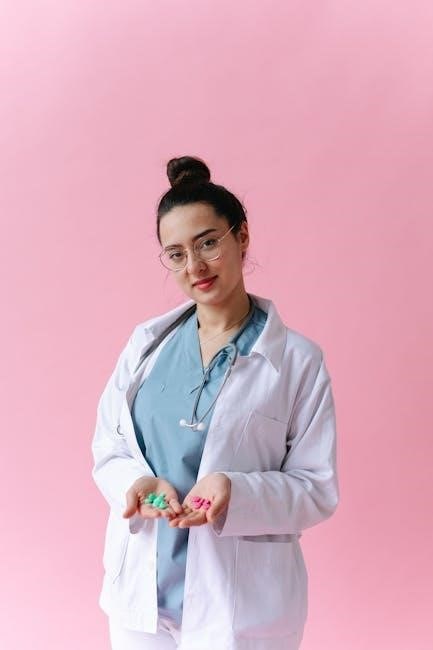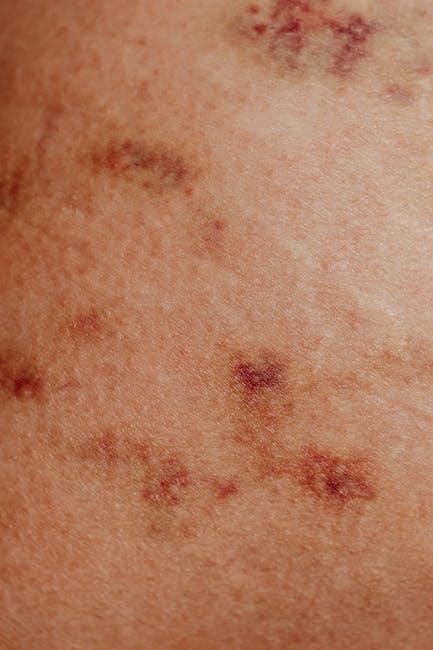Severs Disease, or calcaneal apophysitis, is a common heel condition in children, causing pain due to inflammation of the growth plate. Treatment focuses on reducing pain and inflammation, promoting healing through rest, ice therapy, stretching, and orthotics. Activity modification and supportive footwear are key, while medications may alleviate symptoms. Early intervention ensures optimal recovery and prevents long-term issues.
Definition and Overview
Severs Disease, also known as calcaneal apophysitis, is a common heel condition affecting children and adolescents. It occurs due to inflammation of the growth plate in the calcaneus bone, causing pain and tenderness. Typically seen in active children, it is often linked to repetitive stress from sports or high-impact activities. Symptoms include heel pain, limping, and difficulty walking. While it is a self-limiting condition that resolves with growth, proper management is essential to alleviate symptoms and prevent complications. It is not a disease but an overuse injury requiring conservative treatment approaches.
Importance of Proper Treatment
Proper treatment of Severs Disease is crucial to alleviate pain, reduce inflammation, and prevent long-term complications. Untreated cases can lead to chronic heel pain, limited mobility, and increased risk of reinjury. Early intervention ensures the condition does not interfere with a child’s physical development or athletic activities. Addressing the root causes, such as overuse or improper footwear, helps prevent recurrence. Timely care also minimizes the need for more invasive treatments later on, allowing for a faster return to normal activities and sports. Early diagnosis and tailored treatment plans are essential for optimal recovery.

Treatment Options for Severs Disease
Common treatment options include rest, ice therapy, stretching exercises, and orthotics to manage symptoms effectively and promote healing.
Rest and Activity Modification
Rest is crucial in managing Severs Disease, as it allows the inflamed growth plate to heal. Reducing or completely stopping high-impact activities like running or jumping helps alleviate pain and inflammation. Substituting with low-impact exercises, such as swimming or cycling, can maintain fitness without stressing the heel. Limiting participation in sports and avoiding activities that worsen symptoms are essential. Full rest during the recovery period ensures proper healing and prevents further irritation. Activity modification is tailored to the child’s symptoms, with gradual resumption of activities once pain subsides.
Ice Therapy and Compression
Ice therapy is a cornerstone in reducing pain and inflammation for Severs Disease. Applying an ice pack or cold compress to the affected heel can significantly alleviate discomfort. Typically, ice should be applied for 15-20 minutes every 1-2 hours during the acute phase. Compression, such as using an elastic bandage, helps reduce swelling by limiting fluid accumulation around the heel. These methods, combined with rest, form the initial steps in managing symptoms effectively. Regular application of ice and compression can accelerate recovery and improve mobility in children with Severs Disease.
Stretching and Strengthening Exercises
Stretching and strengthening exercises are essential for managing Severs Disease, focusing on the calf muscles, Achilles tendon, and plantar fascia. Gentle stretching of the triceps surae muscle can reduce tension on the heel, while strengthening exercises improve muscle support. Regular exercises, such as heel raises, calf stretches, and step stretches, promote flexibility and strength. These exercises should be performed 2-3 times daily to alleviate symptoms and prevent recurrence. Consistent practice helps the heel grow stronger, reducing discomfort during physical activities and enhancing overall recovery.
Orthotics and Supportive Footwear
Orthotics and supportive footwear play a crucial role in managing Severs Disease by redistributing pressure and reducing stress on the heel. Custom orthotic inserts can help correct gait abnormalities and provide cushioning, while supportive shoes with good arch support and shock absorption are recommended. Heel cushions or gel pads can also be used to reduce discomfort during activity. These interventions help alleviate pain and inflammation, allowing the heel to heal. Proper footwear is essential for preventing recurrence and supporting long-term recovery. Consulting a podiatrist for tailored orthotic solutions is often beneficial.
Medications and Pain Relief
Medications and pain relief strategies are essential for managing Severs Disease symptoms. Over-the-counter NSAIDs like ibuprofen can reduce inflammation and alleviate pain effectively. Topical creams may also provide localized relief, while in severe cases, stronger prescriptions might be necessary. Always consult a healthcare professional before starting any medication to ensure appropriate treatment.
Non-Steroidal Anti-Inflammatory Drugs (NSAIDs)
NSAIDs are commonly prescribed to manage pain and inflammation in Severs Disease; Ibuprofen and naproxen are frequently recommended for their anti-inflammatory properties. These medications help reduce swelling and discomfort, allowing children to resume normal activities. However, NSAIDs should be used as directed to avoid gastrointestinal side effects. They are most effective when combined with rest and physical therapy, addressing both pain and inflammation. Always consult a healthcare provider before starting NSAIDs to ensure proper dosage and safety. This approach supports healing while maintaining the child’s quality of life during recovery.
Topical Pain Relief Options
Topical creams, ointments, and gels can provide localized relief for heel pain caused by Severs Disease. Ingredients like capsaicin, arnica, and menthol are commonly used to reduce inflammation and numb the area. These products are applied directly to the affected heel, offering immediate, targeted relief without systemic side effects. They are particularly useful for mild to moderate pain and can complement oral medications. Topical treatments are easy to administer and can be used alongside rest, ice, and stretching exercises. Always consult a healthcare provider before using any new topical medication to ensure safety and effectiveness.

Physical Therapy and Rehabilitation
Physical therapy plays a crucial role in Severs Disease recovery, focusing on tailored exercise programs to improve flexibility, strength, and gait mechanics. Kinesiotherapy and orthotic supports enhance recovery.
Kinesiotherapy and Exercise Programs
Kinesiotherapy and structured exercise programs are essential for managing Severs Disease, focusing on improving flexibility, strength, and proper gait mechanics. Gentle stretching exercises target the Achilles tendon and calf muscles, while strengthening exercises enhance muscle support around the heel. Balance and proprioception training are also incorporated to prevent re-injury. Supervised programs ensure exercises are performed correctly, avoiding overexertion. Consistency is key, as these therapies promote healing, reduce pain, and restore normal function, enabling a gradual return to physical activities while minimizing the risk of future issues. Regular monitoring by a therapist ensures progress and safety.

Heel Cushions and Foot Orthoses
Heel cushions and foot orthoses are effective in managing Severs Disease by reducing stress on the heel. Heel cushions provide padding, absorbing impact during activities, while orthoses correct foot alignment and redistribute pressure. Custom orthotics can address specific gait issues, offering additional support. These devices are often recommended alongside rest and physical therapy to enhance recovery. They help alleviate pain and prevent further inflammation, making them a crucial component of conservative treatment plans. Regular use ensures long-term comfort and supports the healing process effectively.
When to See a Doctor
Consult a doctor if your child experiences severe heel pain, limping, or difficulty walking. Professional assessment ensures proper diagnosis and effective treatment plans for Severs Disease.
Indications for Medical Consultation
Severe heel pain, persistent limping, or difficulty walking are key reasons to consult a doctor. If pain worsens despite rest and home care, seek medical advice. A doctor can confirm the diagnosis through physical exams or imaging, ruling out other conditions. They offer tailored treatment plans, ensuring proper healing and preventing complications. Early consultation is crucial for effective management and recovery. Timely medical intervention helps in addressing chronic cases and provides advanced solutions if initial treatments fail.
A professional assessment for Severs Disease involves a thorough physical exam to evaluate heel pain and tenderness. Imaging techniques like X-rays or MRI may be used to rule out fractures or other conditions. A doctor will review the patient’s activity levels and medical history to confirm the diagnosis. Proper assessment ensures an accurate diagnosis and appropriate treatment plan, addressing both acute and chronic cases effectively. Early evaluation by a healthcare professional is essential for managing symptoms and preventing complications. Timely diagnostics lead to targeted interventions, enhancing recovery outcomes. Preventing Severs Disease involves activity modification, proper footwear, and stretching. Long-term management focuses on maintaining a healthy weight, avoiding overuse, and strengthening exercises to reduce recurrence risk and promote overall foot health. Lifestyle adjustments play a crucial role in managing Severs Disease. Reducing high-impact activities and replacing them with low-impact alternatives, such as swimming or cycling, can significantly alleviate symptoms. Limiting participation in sports that involve repetitive running or jumping helps reduce stress on the heel. Encouraging cross-training and monitoring activity levels ensures the heel has adequate time to heal. Additionally, maintaining a healthy weight and avoiding prolonged standing or walking on hard surfaces can further prevent aggravation of the condition, promoting long-term recovery and overall well-being. Education and awareness are essential for effectively managing Severs Disease. Parents, athletes, and coaches should understand the condition’s causes, symptoms, and treatment options. Recognizing early signs, such as heel pain during physical activity, is crucial for prompt intervention. Teaching proper warm-up routines, stretching techniques, and footwear selection can prevent exacerbation. Informing families about the importance of rest and activity modification helps ensure compliance with treatment plans. Raising awareness fosters a proactive approach, reducing the risk of complications and promoting quicker recovery for young athletes.Diagnostics and Professional Assessment

Prevention and Long-Term Management
Lifestyle Adjustments and Activity Modifications
Education and Awareness